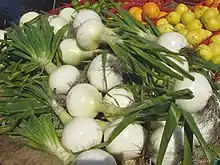Sweet onion
A sweet onion is a variety of onion that is not pungent. Their mildness is attributable to their low sulfur content and high water content when compared to other onion varieties.

| Nutritional value per 100 g (3.5 oz) | |
|---|---|
| Energy | 133 kJ (32 kcal) |
7.55 g | |
| Sugars | 5.02 |
| Dietary fiber | 0.9 g |
0.08 g | |
0.8 g | |
| Vitamins | Quantity %DV† |
| Thiamine (B1) | 4% 0.041 mg |
| Niacin (B3) | 1% 0.133 mg |
| Pantothenic acid (B5) | 2% 0.098 mg |
| Vitamin B6 | 10% 0.13 mg |
| Folate (B9) | 6% 23 μg |
| Vitamin C | 6% 4.8 mg |
| Minerals | Quantity %DV† |
| Calcium | 2% 20 mg |
| Iron | 2% 0.26 mg |
| Magnesium | 3% 9 mg |
| Manganese | 4% 0.076 mg |
| Phosphorus | 4% 27 mg |
| Potassium | 3% 119 mg |
| Sodium | 1% 8 mg |
| Zinc | 1% 0.13 mg |
| |
| †Percentages are roughly approximated using US recommendations for adults. Source: USDA FoodData Central | |
Origins in the United States
United States sweet onions originated in several places during the early twentieth century.
Vidalia onions were first grown near Vidalia, Georgia, in the early 1930s. Today, the name refers to onions grown in a 20-county production region in the state of Georgia as defined by both Georgia state statute[1] and by the U.S. Code of Federal Regulations.[2][3]
South Texas also acquired what is known as the 1015 onion in the early 1980s by Dr. Leonard M. Pike, a horticulture professor at Texas A&M University, Texas. 1015 Onions are named for their optimum planting date, October 15. Grown only in the Rio Grande Valley of South Texas, this large, prized onion was developed after ten years of extensive research and testing and a million dollars in cost. As a result, Texas achieved a mild, very sweet onion with the nickname – the "Million Dollar Baby". Onions are Texas' leading vegetable crop. The state produces mostly sweet yellow varieties. The sweet onion was adopted as Texas' official state onion in 1997.
The Walla Walla sweet onion is named for Walla Walla County, Washington, where it is grown.[4][5] Its development began around 1900 when Peter Pieri, a French soldier who settled in the area, brought a sweet onion seed from the island of Corsica with him to the Walla Walla Valley.[6] This sweet onion was developed by selecting and reseeding onions from each year's crop that possessed sweetness, jumbo size, and round shape. It is the designated vegetable of Washington State.[7][8][4] Gov. Christine Gregoire signed the "onion bill" in 2007 to make it the state's official vegetable.[9]
Other U.S. varieties
- Imperial Valley Sweets come from the Imperial Valley in far southern California. This is one of the leading growing areas for sweet onions, although they are available only from late April through June.
- The Carzalia Sweet onion is a variety of sweet onion grown by Carzalia Valley Produce in Columbus, New Mexico.
- The Sunbrero (Texas) Sweet Onion is grown in Texas and distributed by Sweet Onion Trading Company, Melbourne, Florida.
- The Sweetie Sweet is a variety of sweet onion grown in the Mason Valley in Yerington, Nevada. The Sweetie Sweet onion can be found in marketplaces September through the end of January.
- The Glennville sweet onion is grown in Tattnall County, in Glennville, Georgia.
- Mattamuskeet Sweets are a type of sweet onion grown in Eastern North Carolina, especially in eastern Beaufort and Hyde Counties. This particular variety is a popular choice for cooking and consumption amongst residents of coastal Carolina, and is named for Lake Mattamuskeet in central Hyde County.
- Maui onions are one of the smaller varieties of onions grown on the Hawaiian island of Maui. They are trademarked "Kula-grown" onions.
- Pecos onions are sweet onions grown in the Pecos Valley in the state of Texas.
Bermuda onions
The Bermuda onion is a variety of sweet onion grown on the island of Bermuda. The seeds were originally imported from the Canary Islands before 1888. Onion export to the United States became such a prominent feature of Bermudian life, the Bermudians started calling themselves onions. Sweet onions from Texas largely displaced the Bermuda variety.[10]
European onions
In Europe, Oignon doux des Cévennes, Cipolla Rossa di Tropea Calabria and Cebolla Dulce de Fuentes are well known and tasty sweet onions. The Oignon doux des Cévennes from Cévennes, South East France and the Cipolla Rossa di Tropea Calabria from Tropea, Calabria, Southern Italy, have PDO status. The Cebolla Dulce de Fuentes is an open variety original from Zaragoza province, Northeast Spain, and traditionally grown by producers there.
References
- Georgia General Assembly. "Vidalia Onion Act of 1986, O.C.G.A. § 2-14-130 et seq." (PDF). Georgia Department of Agriculture. Retrieved 2017-05-31.
- 7 C.F.R. §955.5
- "Super greens Powder".
- "State Symbols". Washington State Legislature. Retrieved 2017-05-31.
- "History of Walla Walla - Continued". 2007. Archived from the original on 2012-03-05. Retrieved 2017-05-31.
- Mendelson, Kathy (2009-11-09). "Famous People You Never Heard Of: Notable Gardeners, Horticulturists, Botanists, and Landscape Gardeners from the Pacific Northwest". Retrieved 2017-05-31.
- "Sweet Onion Varieties - Home Cooking". About.com. 2016-02-10. Archived from the original on 2017-02-23. Retrieved 2017-05-31.
{{cite web}}: CS1 maint: unfit URL (link) - "Sweet Texas Onions 1015 Information, Recipes and Facts". specialtyproduce.com. Retrieved 2017-05-31.
- "Walla Walla Sweet Onion now is the state vegetable". The Seattle Times. 2007-04-21. Retrieved 2017-12-14.
- Oulton, Randal (2005-09-09). "Bermuda Onions". cooksinfo.com. Retrieved 2017-05-31.
.jpg.webp)